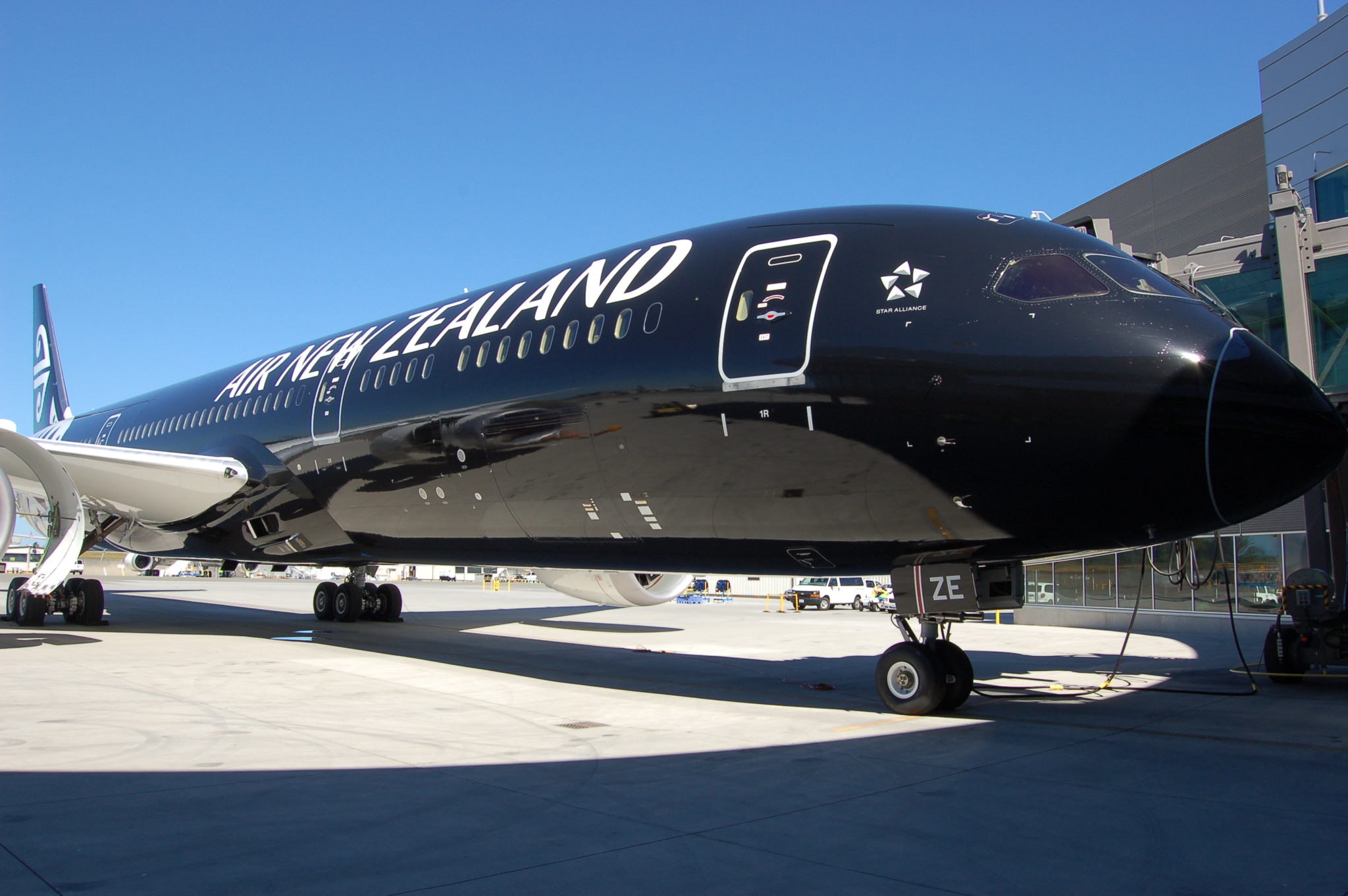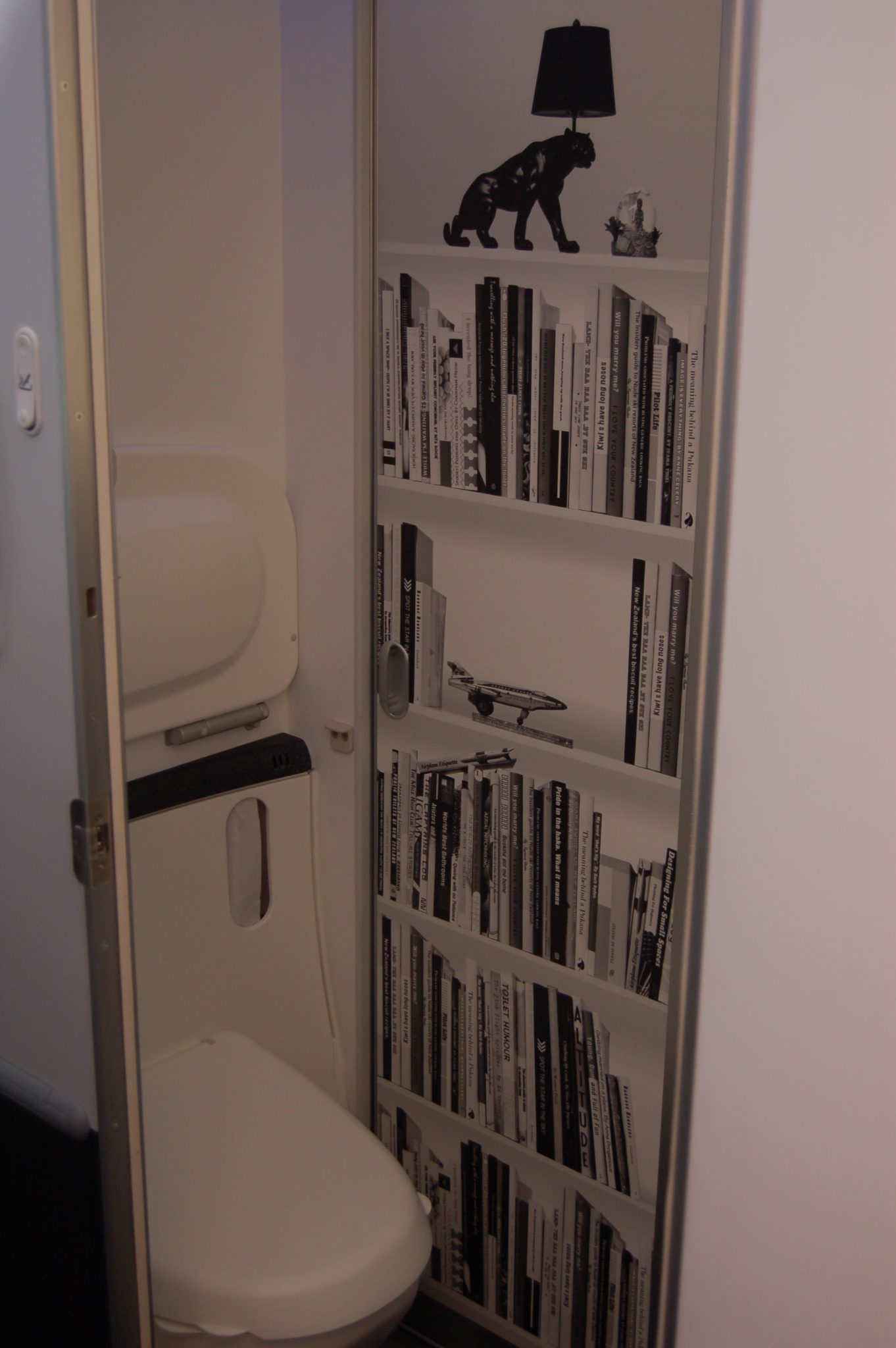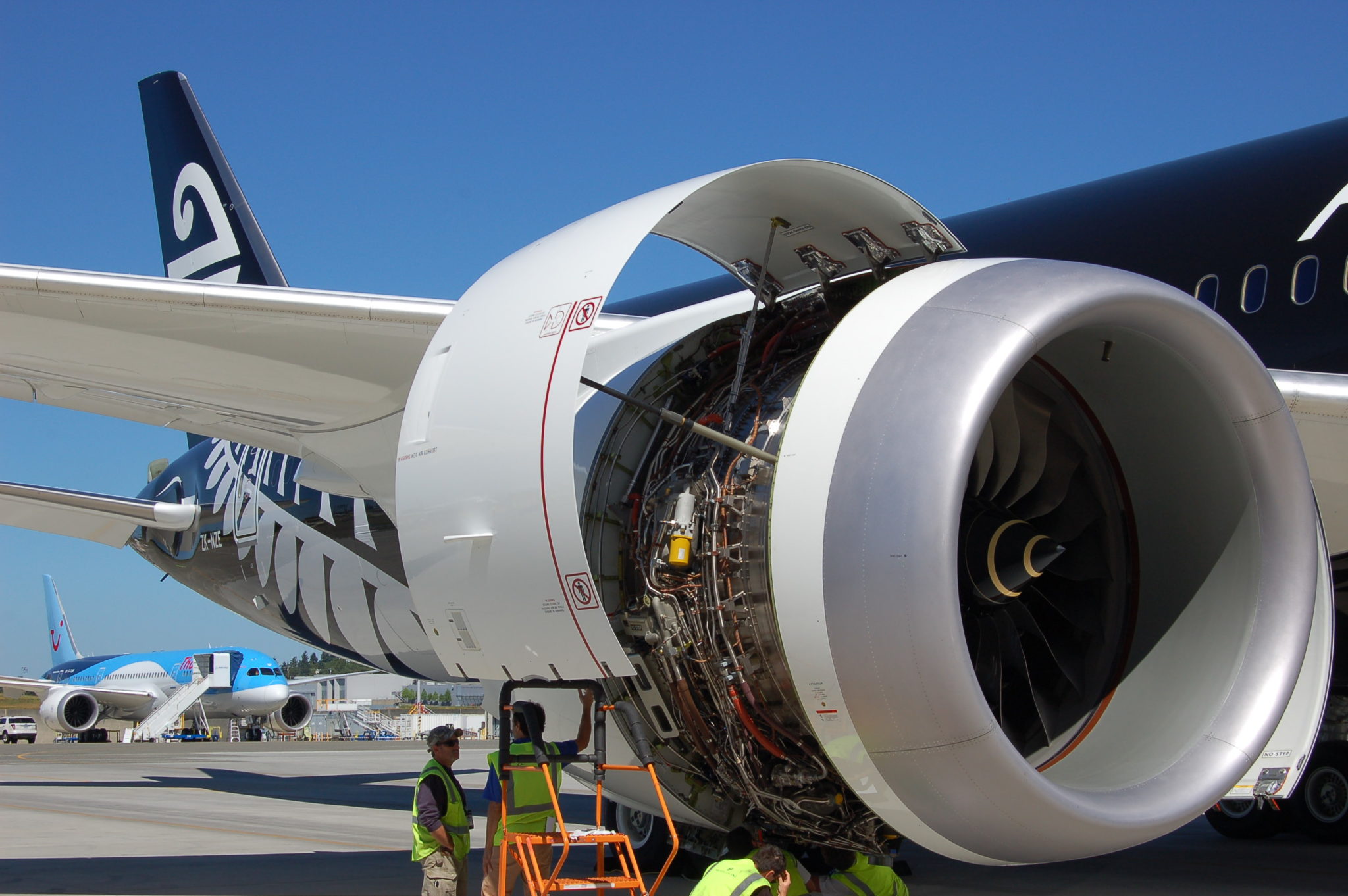Leeham News and Analysis
There's more to real news than a news release.
Air New Zealand shows off first 787-9
Air New Zealand and Boeing displayed the industry’s first 787-9, of which ANZ is the launch customer, in a media show-and-tell today.
ANZ touted its black-painted exterior and black-decorated interior for what it called a game-changing airplane that is better than the 787-8. Officials noted this is the first time an airplane stretch has more range than the shorter version.

Air New Zealand is the launch customer for the Boeing 787-9. It displayed the plane July 9 in a show-and-tell for international media. Photo by Scott Hamilton.
Boeing officials pointed to a more efficient production system, better engineering and lessons learned from the 787-8 program that produced an airplane that is expected to at least match the current dispatch reliability of the 787-8, if not better it, upon entry-into-service in the coming weeks. The 787-8 had a difficult EIS and a lower-than-expected dispatch reliability. Lessons learned should overcome all these disappointments.
Rolls-Royce was also present, touting the Trent 1000 on the 787-9, which the official there said is up to specifications; the earlier Trents on the 787-8 initially fell short and were subject to several Performance Improvement Packages (PIPs) to bring them to spec.
The 787-9 is a milestone for the program, agrees Mark Jenks, VP 787 Airplane Development. Software problems, design challenges, too much weight and other issues that plagued the 787-8 have been eliminated in the 787-9, he says. Work was brought back in-house to Boeing and more engineering was done by Boeing than by outsourced companies. All of this serves to prepare the sub-type for a smooth EIS, he says.
The 787-9 also has 330 minute ETOPS, though Capt. David Morgan of ANZ–the company’s test pilot–says ANZ doesn’t expect to use it in the near term. ANZ is currently only using 220 minute ETOPS (by the Boeing 777-300ER). New Zealand to South America will eventually be served by the 787 and 330 ETOPS will be needed then.
(As an aside, Morgan said that on the 777 routes, the ETOPS is used to sometimes fly a slightly longer route but with more favorable winds, reducing fuel burn and carbon emissions despite adding 5-6 minutes to the flight time. While this is inconsequential to passengers, the time saved per flight over the course of the year adds up to real savings and reduced emissions.)
Entering the ANZ plane, complete with the mood lighting that is a feature of the 787, is dominated by black seats and trim–something that intuitively is not a design feature that would seem to work–but it does.

Air New Zealand offers an option in coach to buy all three seats, which permits a bed to be created. Photo by Scott Hamilton.
One of the more interesting features created by ANZ is something to spruce up one of the most necessary but least aesthetic areas of the airplane: the bathroom. ANZ decorated the bathrooms with designer wall paper. One design is quite fitting: illustrations of bookshelves of books, suitable for any reading room.

In a photo the books may look real but it’s only wall paper. Still, Air New Zealand–known for its humorous flight safety videos–makes the toilet look like any reading room. Photo by Scott Hamilton.
Rolls-Royce said the 787-9’s engine incorporates improvements from the 787-8’s early Trent 1000 model and that the forthcoming 787-10’s Trent 1000 TEN (pronounced T-E-N, not “ten”) will have features from the Trent XWB developed for the Airbus A350 XWB that will improve fuel consumption and be lighter weight.
ANZ gets its next -9s in September and October. This one will initially serve Australia and routes that follow will be to Asia. Eventually the -9 will serve Vancouver, Canada, a 14 1/2 hour flight.



HOPEFULLY it will after a few months of long range flights in service will validate the ‘ better” efficiency and longer range. Maybe a contributor could be a smaller vertical tail due to better leverage in an engine out, with reduced drag plus other tweaks ??
Huh? Fuel burn specs are known on the -8 and have been validated on the -9 flight tests.
You really think Boeing doesn’t know what sized tail they need?
I think more hopefully we leave design to engineers.
Uhh trans world _ please read my comment again- carefully. My point was that a longer fuselage provides a longer lever arm to react an engine out on takeoff with a somewhat smaller rudder and therefore less drag which in turn would help the overall efficiency. Nowhere did I say or infer that Boeing didn’t know what size tail needed but only postulated that may be a contributing factor. BTW fuel burn specs being validated on the -9 is only a starting point- it usually takes in service data over a period of time over various wind, altitude, temperature, etc conditions to come up with real world data.
Of course you might believe that -9 fight tests cover ALL conditions of passenger, fuel, etc for every combination possible ? If so, I’ve got this bridge . . .
One of the “tweaks” on the -9 vertical tail is a HLFC system, which I believe is on the horizontal tail as well.
Mike – you are correct, HLFC is installed on both the vertical fin and the horizontal stabilizer of the 787-9.
Congrats to Boeing and ANZ on the first B-787-9 delivery.
At one point in the 2000s Air New Zealand were considering a340s! Luckily they decided otherwise and booked early 787-9 slots, before the design was even firmed, and 777s to replace their 747 fleet.
Due to delays they’ve had to make do with leased 773s but have crafted a good trans-Pacific long-haul airline in the meantime. I believe they have the longest average international flights of any airline in the world. Whether that’s true, they are particularly vulnerable to fuel prices. This aircraft will be of huge value to their fleet for some time.
The three seats option fr a bed solution is in my opinion an insult. I remember these NWA empty rows in the back in the md11 were bed for the resting crews…
Sorry..
One of the reasons for the empty seats in the MD11 was due to the MDC aero types having screwed up on wing design, and as a result they could not meet range/load guarantees. So MDC had to pick up the ‘ costs” via a subsidy on many long range flights. So they came to BA and partly screwed up the 737 wing, while claiming that the trailing edge inboard ‘ wedge’ would fix or aid the 37 wing. wrong again. Thus we come to the aeropartners winglets . .
Fully black paint? A good test for the environmental control system!
During cruise the outside temperature is far below zero degree Celsius. Due to the insulation it will take several hours for the heat to reach the inside but then the system has to cope with about 300 kW (1 kW per m² x 5.75 m fuselage diameter x 55 m fuselage length) and 30 kW for 300 pax.
The 787-9 will prove or disprove the Boeing theories that the 787 program is a game changer or not. The 160+ plus copies of -8s are out with a host of varying configs (weight, and engine PIPs) and now the -9 benefits from all. If this copy, by October, meets or exceeds performance expectations or varying ANZ routes the world will know whether Boeing and its suppliers have leveraged the -8. It is this frame and the first with ANA that will be the program’s story. ANA’s -9 will be excellent because they have -8 history and real comparative data.